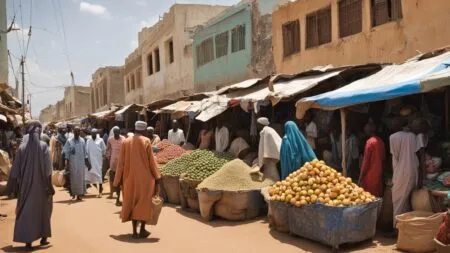The last week saw a patchwork of market patterns in Somalia’s always unstable economy, with disparate commodities seeing varied price movements. One thing remained steady in the midst of all the change: Galmudug’s market held steady despite the ebbing and flowing.
Improvements in Transportation’s Effect on Market Prices
The improvement in transportation that was previously hindered by flooding has resulted in a decrease in prices for both food and non-food items. This development’s echo was particularly noticeable in the nearby cereal markets of Southwest, Puntland, and Hirshabelle, where prices began to decline. Conversely, cereal prices in Jubaland and Somaliland increased by 2 to 8 percent.
The Market’s Story in Mogadishu
A notable twenty percent price increase for red sorghum was observed in Mogadishu’s busy market lanes as a result of a shortage brought on by demand. On the other hand, due to the influx from the production areas, maize prices dropped by 17 percent. The restoration of supply chains also had a knock-on effect on the prices of imported foods, including rice, pasta, wheat flour, sugar, and vegetable oil, in Mogadishu, Jubaland, and Hirshabelle.
Price Trends in Various Commodities
The prices of pasta, vegetable oil, and wheat flour, however, slightly increased in Southwest, defying the general trend and being linked to an increase in diesel prices. A parallel market saw a spike in camel milk prices as a result of a declining supply; increases were noted at 12% in Puntland, 3% in Jubaland, and 2% in Hirshabelle. In contrast, prices for goats remained stable or even dropped across the states, indicating an increased supply. Fuel prices and wage labor rates remained stable, with the exception of a 6% increase in fuel prices in the Southwest.
Even in the middle of these shifting sands, Somalia’s exchange rates demonstrated an impressive level of stability. Furthermore, it was discovered that overall market availability was adequate, despite occasional shortages in remote markets like Kismaayo, Badhaadhe, Afgooye, Cadale, Baidoa, Burco, Diinsoor, and Belet Xaawo. Though there were reports of some localized stock reductions, the markets were stocked with a wide range of brands and quantities.
Regarding the quality of the commodities, all the states reported the same good standard. Market resilience was especially notable in areas impacted by river flooding, as steady supplies were guaranteed. By the end of the week, the flow of goods to markets was more easily maintained because major roads and corridors were once again accessible following disruptions caused by rainfall. This was a significant improvement in logistical conditions.
As a result, even though market trends in Somalia are still changing and meandering, they nevertheless provide an inspiring picture of a country’s economy that is battling against all odds and that is unfazed by change.
Topics #Commodities #Exchange Rates #Galmudug #Market Resilience #Mogadishu #Somalia #Transportation











